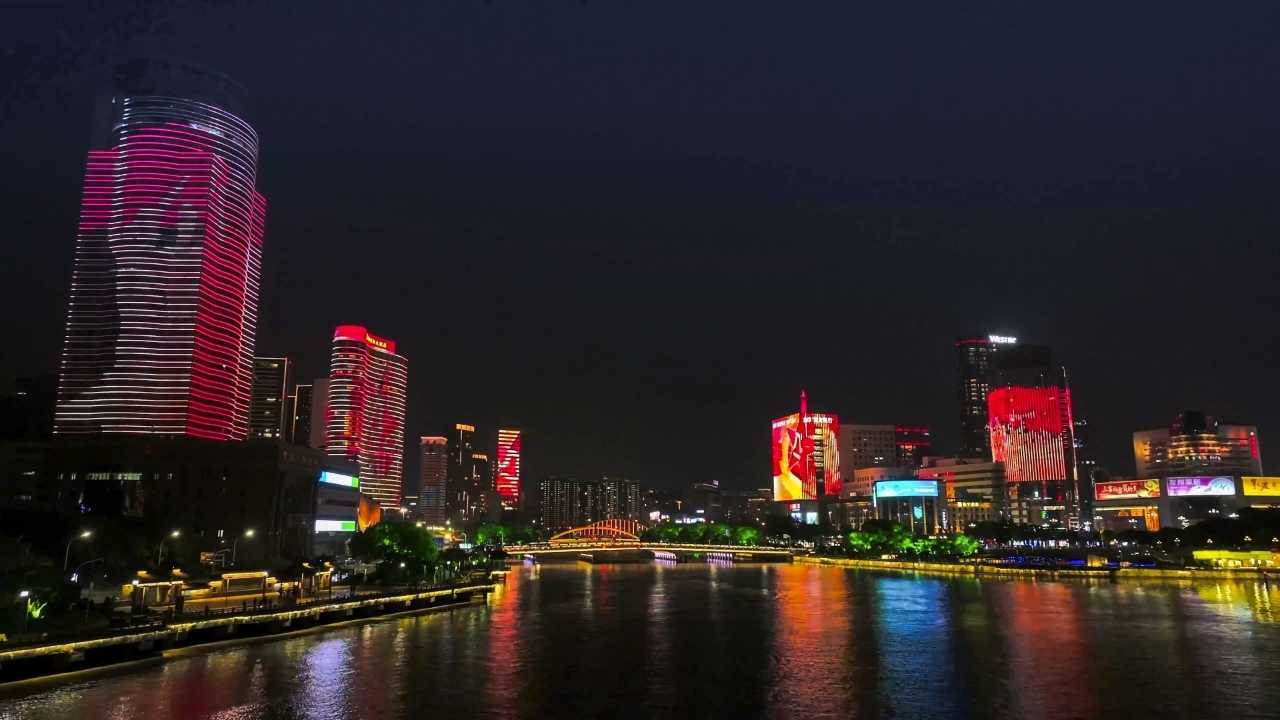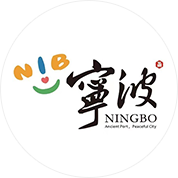
Sanjiangkou of Ningbo. (Photo by Yongpai App)
Ningbo (known as Mingzhou in ancient times), located in the middle section of China's mainland coastline, enjoys the advantages of rivers, lakes, and seas.
To the north and east, it connected to the Korean Peninsula, the Japanese Archipelago, and the southeastern coast, while to the south, via the Fujian and Guangdong coasts, it extended to the Nanyang (Southeast Asia) and Xiyang (Indian Ocean) regions. This unique natural and geographical position made Ningbo a major port for China's ancient maritime exchanges, and the city flourished alongside the development of the Maritime Silk Road.
Ningbo is one of the earliest regions where humans engaged in shallow-sea activities. Excavations at the Hemudu primitive mooring site, including dugout canoes, wooden paddles, and pottery boat models, indicate that Ningbo's ancestors were already navigating rivers, lakes, and seas as early as 7,000 years ago, engaging in water-based production activities. During the Spring and Autumn period, King Goujian of Yue established the Gouzhang Port, built warships, and developed a naval force while attracting maritime traders, transforming it into a significant port with both military and commercial functions.
If the Hemudu culture represents the origin of Ningbo's Maritime Silk Road and Gouzhang Port its historical foundation, then the numerous imported artifacts unearthed from Han Dynasty sites and the vast quantities of exported ceramics produced at the ancient kiln sites of Shanglinhu Lake mark a new milestone. These discoveries signify that Ningbo's maritime culture had entered an era centred on dialogue between Eastern and Western civilizations.
Over six centuries of development from the Qin to the Jin Dynasty, the regional economy of the Sanjiang area thrived, with trade and cultural exchanges expanding domestically and internationally. The creation and export of mature celadon became a major industry in the regional economy. Mirror-making craftsmen from Wu travelled eastward to Japan via Gouzhang Port, bringing advanced mirror-making techniques. Indian monk Narayana arrived via waterways to meditate in the Wulei Mountains of Gouzhang. While exporting goods, Ningbo also served as an entry point for many imported products. The Sanjiangkou area became an early hub for overseas trade and cultural exchange.
In the 26th year of the Tang Kaiyuan era (738 AD), Mingzhou was established as a prefecture, and in the first year of the Tang Changqing era (821 AD), its administrative center was relocated to Sanjiangkou. Leveraging its port advantages, Mingzhou expanded its city walls, built ports, established official shipyards, and extended its hinterland, gradually becoming one of China's most developed regions for ports and shipbuilding. Mingzhou merchant groups transported large quantities of religious items, spices, medicines, silk, ceramics, and books to Japan, Silla, and Southeast Asia. Master Jianzhen and others departed from Mingzhou to preach Buddhism in Japan, while Japanese monks like Saichō followed the Japanese envoys to Tang China to study Buddhism in Mingzhou before returning to spread its teachings. The region's most important trade commodity, Yue kiln celadon, was exported in large quantities to various Asian countries.
During the Song and Yuan dynasties, Ningbo's Maritime Silk Road reached its peak, building on the significant progress made in the Tang Dynasty. In the third year of the Song Chunhua era (924 AD), the Mingzhou Maritime Trade Office was established to oversee overseas trade, becoming one of the "Three Offices." In trade with Japan, Mingzhou served as a hub port, with frequent exchanges between merchants from both countries. Goods exported from Mingzhou to Japan included coins, ceramics, incense, medicines, books, paintings, and silk textiles, while Japan exported gold, timber, and sulfur. With the Korean Peninsula, Mingzhou was a key port for trade between China and Goryeo during the Song and Yuan periods. In the mid-to-late Northern Song alone, Mingzhou merchants travelled to Goryeo for trade 120 times, exporting tea, ceramics, and silk textiles and importing ginseng, musk, and safflower.
In the seventh year of the Song Xining era (1074 AD), Mingzhou officially replaced Dengzhou as the designated port for trade with Goryeo. In the seventh year of the Zhenghe era (1117 AD), the court built a dedicated Goryeo Embassy in Mingzhou to host Goryeo envoys and merchants. In trade with Southeast and West Asia, during Emperor Shenzong's reign, the Northern Song court granted Mingzhou the authority to issue visas for voyages to Southeast Asian countries, leading to increasingly frequent trade with Southeast Asia, South Asia, and West Asia. Mingzhou had a Persian Hall dedicated to hosting Arab merchants, and Arabs also built a mosque in the city.
Through the Maritime Silk Road, Mingzhou actively facilitated cultural and technological exchanges. In the first half of the 10th century, Yue kiln porcelain-making techniques were transmitted to the Korean Peninsula, where artisans produced exquisite "kingfisher-colour" celadon, rapidly turning the region into an exporter of celadon. Japanese monks like Eisai and Dōgen, Goryeo monk Uitong, and Uicheon, the fourth son of King Munjong of Goryeo, all studied Buddhism in Mingzhou before returning to become prominent Buddhist figures in their homelands. Meanwhile, Chinese monks like Lanxi Daolong and Mugaku Sogen travelled to Japan to spread Buddhism, greatly advancing Japanese Buddhism. During the Southern Song, Buddhist architecture from eastern Zhejiang was directly transplanted to Japan, influencing the "Tenjiku-yō" (or "Great Buddha style") of the Kamakura period.
When Southern Song craftsmen like Yi Xingmo travelled to Japan, they introduced Chinese woodcarving and stone-carving arts, promoting the development of Kamakura-era sculpture and stone architecture. In the Chejiao Street and Shiban Alley areas of Song-Yuan Mingzhou (Qingyuan), art studios flourished, and professional painters like Lu Xinzhong, Jin Dashou, and Lu Zhongyuan created Buddhist paintings eagerly purchased by Japanese merchants and monks, becoming treasured collections and models for copying in Japanese temples.
During the Ming and Qing dynasties, maritime prohibition became the dominant policy, leading to the decline of the once-thriving Maritime Silk Road. However, despite strict bans on sea travel, Ningbo remained significant. The establishment of the tally trade system designated Ningbo as the sole port for receiving Japanese "tribute ships." The Ming court set up the Siming Post to accommodate and facilitate Japanese envoys travelling to the capital and established the Ningbo Maritime Trade Office, restricting the port to handling only Japanese tally trade ships. Ningbo played a unique role in maintaining diplomatic relations between the Ming Dynasty and Japan. The cultural exchanges "smuggled" through the tally trade ensured that Ningbo, continuing the legacy of the Tang and Song dynasties, remained a destination revered by Japanese monks and intellectuals. Figures like the Japanese painting master Sesshū Tōyō, monk Sakugen Shūryō, and Ningbo Confucian scholar Zhu Zhiyu became emblematic of Sino-Japanese cultural exchanges during this period.
China's ancient Maritime Silk Road ultimately declined after its final glory during Zheng He's voyages, while the Opium War marked the beginning of China's modern history. Ningbo, the cradle of China's maritime civilisation, transformed alongside the tides of history. Today, the development of Ningbo's maritime economy and the rise of its port owe much to the enduring maritime culture accumulated over centuries as a starting point of China's ancient Maritime Silk Road, as well as to the maritime consciousness and spirit cultivated over millennia. These invaluable maritime traditions, awareness, and ethos will continue to propel Ningbo, the "Oriental Ark," forward, guiding the city as it writes a new chapter in the history of the Maritime Silk Road.
Source: Ningbo Daily
Editor: Ye Ke



